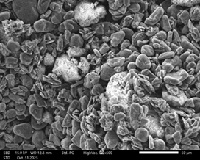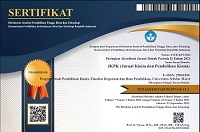
Characterization of SiO₂/C Composites from Bamboo Leaves and Graphite for Lithium-Ion Battery Anode
Abstract
Silicon dioxide (SiO₂) is a key component found in various biomass materials, including bamboo leaves. This study aims to synthesize SiO₂/C composites using bamboo leaves as the silica source and graphite as the carbon source, targeting their application as anode materials in lithium-ion batteries (LIBs). Silica particles were first prepared using the sol-gel method and characterized by Fourier Transform Infrared Spectroscopy (FTIR), X-ray Diffraction (XRD), and Scanning Electron Microscopy (SEM). The SiO₂/C composite was synthesized through a solid-state reaction by mixing SiO₂ and graphite in varying SiO₂ weight percentages of 0%, 5%, 20%, and 100%, followed by calcination at 500 °C for 30 minutes under argon atmosphere. The morphology and composition of the resulting composites were analyzed using SEM-EDX. These composites were then employed as anode materials in LIBs, paired with a nickel manganese cobalt oxide (NMC) cathode. Electrochemical performance was assessed using a battery analyzer, and charge-discharge cycle (CDC) data were obtained. The addition of carbon significantly improved the electrochemical performance. Specifically, the composite with 100% SiO₂ showed a low capacity of 9.88 mAh/g, while those with 5% and 20% SiO₂ demonstrated significantly enhanced specific capacities of 97.35 mAh/g and 129.34 mAh/g, respectively, after five cycles.
Keywords
Full Text:
PDFReferences
[1] M. Khan, X. Ding, H. Zhao, Y. Wang, N. Zhang, X. Chen, J. Xu, SiO2‑Based Lithium‑Ion Battery Anode Materials : A Brief Review, (2022). available: https://link.springer.com/article/10.1007/s11664-022-09628-1
[2] M.R. Buga, A.A. Spinu-Zaulet, C.G. Ungureanu, R.A. Mitran, E. Vasile, M. Florea, F. Neatu, Carbon-coated sio2 composites as promising anode material for li-ion batteries, Molecules. 26 (2021) 1–15. doi:10.3390/molecules26154531.
[3] J. Cui, F. Cheng, J. Lin, J. Yang, K. Jiang, Z. Wen, J. Sun, High surface area C/SiO2 composites from rice husks as a high-performance anode for lithium ion batteries, Powder Technol. 311 (2017) 1–8. doi:10.1016/j.powtec.2017.01.083.
[4] N.P. Har, E.K. Palupi, Irmansyah, Irzaman, Analysis of the electrical impedance and functional group of silicon dioxide (SiO2) from rice straw, IOP Conf. Ser. Earth Environ. Sci. 460 (2020). doi:10.1088/1755-1315/460/1/012031.
[5] A. Sarker, A.S. Rabbi, N.A. Nadi, A.K.M.L. Rahman, A.A. Momin, K.S. Ahmed, H.A. Simol, Structural and transport properties of newly synthesized ZSM-5 sourcing silica from coconut shell ash, Results Chem. 11 (2024). doi:10.1016/j.rechem.2024.101810.
[6] F.S. B, Y. Al Adawiyah, M.I. Santoso, Synthesis and Characterization of Silica Gel from Corn Cob Skin and Cob Waste, Proc. 2nd Int. Conf. Smart Agric. Food, Environ. (ICSAFE 2021). 1 (2023) 55–62. doi:10.2991/978-94-6463-090-9.
[7] Q. Wang, H. Tian, J. Miao, C. Zhang, J. Zhang, Y. Zhang, Y. Guo, A waste corn cob core-derived SiO2 @ graphene-like carbon nanocomposite and its application in lithium-ion battery, J. Mater. Sci. Mater. Electron. 32 (2021) 1278–1288. doi:10.1007/s10854-020-04901-7.
[8] Y.L. Ni’Mah, Z.H. Muhaiminah, S. Suprapto, Increase of solid polymer electrolyte ionic conductivity using nano-sio2 synthesized from sugarcane bagasse as filler, Polymers (Basel). 13 (2021). doi:10.3390/polym13234240.
[9] S. Silviana, W.J. Bayu, Silicon Conversion from Bamboo Leaf Silica by Magnesiothermic Reduction for Development of Li-ion Baterry Anode, MATEC Web Conf. 156 (2018) 0–3. doi:10.1051/matecconf/201815605021.
[10] R. Hartono, A.H. Iswanto, T. Priadi, E. Herawati, F. Farizky, J. Sutiawan, I. Sumardi, Physical, Chemical, and Mechanical Properties of Six Bamboo from Sumatera Island Indonesia and Its Potential Applications for Composite Materials, Polymers (Basel). 14 (2022). doi:10.3390/polym14224868.
[11] N. Gautam, Y. Rajesh, N. Kale, M. Jagtap, H. Chaudhari, S. Pansare, Silica extraction from bamboo leaves using alkaline extraction method, Mater. Today Proc. (2023). doi:10.1016/j.matpr.2023.12.014.
[12] D. Sui, M. Yao, L. Si, K. Yan, J. Shi, J. Wang, C.C. Xu, Y. Zhang, Biomass-derived carbon coated SiO2 nanotubes as superior anode for lithium-ion batteries, Carbon N. Y. 205 (2023) 510–518. doi:10.1016/j.carbon.2023.01.039.
[13] M.S. Al Ja’farawy, D.N. Hikmah, U. Riyadi, A. Purwanto, H. Widiyandari, A Review: The Development of SiO2/C Anode Materials for Lithium-Ion Batteries, J. Electron. Mater. 50 (2021) 6667–6687. doi:10.1007/s11664-021-09187-x.
[14] X. Wu, Z.Q. Shi, C.Y. Wang, J. Jin, Nanostructured SiO2/C composites prepared via electrospinning and their electrochemical properties for lithium ion batteries, J. Electroanal. Chem. 746 (2015) 62–67. doi:10.1016/j.jelechem.2015.03.034.
[15] H. Xia, Z. Yin, F. Zheng, Y. Zhang, Facile synthesis of SiO2/C composites as anode materials for lithium-ion batteries, Mater. Lett. 205 (2017) 83–86. doi:10.1016/j.matlet.2017.06.040.
[16] H. Xu, S. Zhang, W. He, X. Zhang, G. Yang, J. Zhang, X. Shi, L. Wang, SiO2-carbon nanocomposite anodes with a 3D interconnected network and porous structure from bamboo leaves, RSC Adv. 6 (2016) 1930–1937. doi:10.1039/c5ra19961a.
[17] J. Kumchompoo, P. Kunthadee, N. Laorodphan, P. Kidkhunthod, The solid-state reaction facilitated by a microwave-assisted method for lithium vanadium silicon oxide synthesis by incorporating pure silica and rice husk ash for the application as anode material in lithium-ion battery, 207 (2023). doi:10.1016/j.radphyschem.2023.110863.
[18] A. Jumari, C.S. Yudha, H. Widiyandari, A.P. Lestari, R.A. Rosada, S.P. Santosa, A. Purwanto, SiO2/C composite as a high capacity anode material of LiNi0.8Co0.15Al0.05O2 battery derived from coal combustion fly ash, Appl. Sci. 10 (2020) 1–13. doi:10.3390/app10238428.
[19] P.P. Nayak, A.K. Datta, Synthesis of SiO2-Nanoparticles from Rice Husk Ash and its Comparison with Commercial Amorphous Silica through Material Characterization, Silicon. 13 (2021) 1209–1214. doi:10.1007/s12633-020-00509-y.
[20] L. Yuliatun, N. Nuryono, Y. Kamiya, R. Dharmastiti, Preparation and Characterization of White Mineral Trioxide Aggregate (WMTA) using Silica from Rice Husk Ash, JKPK (Jurnal Kim. dan Pendidik. Kim. 7 (2022) 159. doi:10.20961/jkpk.v7i2.57429.
[21] P.E. Imoisili, T.-C. Jen, Synthesis and characterization of amorphous nano silica from South African coal fly ash, Mater. Today Proc. (2023) 0–5. doi:10.1016/j.matpr.2023.06.077.
[22] S. Oudah, S. Meri, A. Absi, A. Hasan, M.S. Roslan, M. Arif, Materials Today : Proceedings Synthesis and characterization of enhanced silica nanoparticle ( SiO 2 ) prepared from rice husk ash immobilized of 3- ( chloropropyl ) triethoxysilanea, Mater. Today Proc. 42 (2021) 2464–2468. doi:10.1016/j.matpr.2020.12.564.
[23] U.R. Joshi, R. Roy, P.G. Satsangi, Investigation of Bamboo Leaves as an Alternative Source of Silica: Extraction, Characterization and Its Application as an Adsorbent for Methylene Blue Sequestration, ChemistrySelect. 7 (2022). doi:10.1002/slct.202200011.
[24] M.C. Kono, M.S. Batu, Y.I. Kedang, R. Seran, XRF and XRD Investigation for the Results of the Extraction of Mud Volcano from Napan Village into Silica, JKPK (Jurnal Kim. dan Pendidik. Kim. 6 (2021) 317. doi:10.20961/jkpk.v6i3.55022.
[25] P. Lv, H. Zhao, J. Wang, X. Liu, T. Zhang, Q. Xia, Facile preparation and electrochemical properties of amorphous SiO 2/C composite as anode material for lithium ion batteries, J. Power Sources. 237 (2013) 291–294. doi:10.1016/j.jpowsour.2013.03.054.
[26] K.M. Jeon, J.H. Kim, Y.J. Choi, Y.C. Kang, Electrochemical properties of hollow copper (II) oxide nanopowders prepared by salt-assisted spray drying process applying nanoscale Kirkendall diffusion, J. Appl. Electrochem. 46 (2016) 469–477. doi:10.1007/s10800-016-0941-5.
[27] E. a O.P.E. Imoisili, S.O.O. Olusunle, Extraction and characterization of Amorphous Silica from Corn Cob Ash by Sol-Gel Method, 3 (2013) 68–73. https://core.ac.uk/download/pdf/234666102.pdf.
[28] N.S. Osman, N. Sapawe, Optimization of silica (SiO2) synthesis from acid leached oil palm frond ash (OPFA) through sol-gel method, Mater. Today Proc. 31 (2020) 232–236. doi:10.1016/j.matpr.2020.05.300.
[29] K. Askaruly, S. Azat, Z. Sartova, M. Yeleuov, A. Kerimkulova, K. Bekseitova, Obtaining and characterization of amorphous silica from rice husk, J. Chem. Technol. Metall. 55 (2020) 88–97. https://journal.uctm.edu/node/j2020-1/12_19-76_p_88-97.pdf.
[30] P. Chindaprasirt, U. Rattanasak, Eco-production of silica from sugarcane bagasse ash for use as a photochromic pigment filler, Sci. Rep. 10 (2020) 1–8. doi:10.1038/s41598-020-66885-y.
[31] A. Casimir, H. Zhang, O. Ogoke, J.C. Amine, J. Lu, G. Wu, Silicon-based anodes for lithium-ion batteries: Effectiveness of materials synthesis and electrode preparation, (2016) 359–376. doi:10.1016/j.nanoen.2016.07.023.
[32] S. Huang, D. Yang, W. Zhang, X. Qiu, Q. Li, C. Li, Microporous and Mesoporous Materials Dual-templated synthesis of mesoporous lignin-derived honeycomb-like porous carbon / SiO 2 composites for high-performance Li-ion battery, J. Homepage. 317 (2021) 1–9. doi:10.1016/j.micromeso.2021.111004.
[33] X. Liu, Y. Chen, H. Liu, Z.Q. Liu, SiO2@C hollow sphere anodes for lithium-ion batteries, J. Mater. Sci. Technol. 33 (2017) 239–245. doi:10.1016/j.jmst.2016.07.021.
[34] X. Sun, Y. Luo, X. Li, Y. Wang, S. Lin, W. Ding, K. Guo, K. Zhang, A. Qin, Pompon Mum-like SiO2/C Nanospheres with High Performance as Anodes for Lithium-Ion Batteries, Batteries. 10 (2024). doi:10.3390/batteries10050149.
[35] Y. Guo, X. Chen, W. Liu, X. Wang, Y.I. Feng, Y. Li, L. Ma, B. Di, Preparation of Rice Husk-Based C / SiO 2 Composites and Their Performance as Anode Materials in Lithium Ion Batteries, 49 (2020). doi:10.1007/s11664-019-07785-4.
[36] J. Cui, J. Yang, J. Man, S. Li, J. Yin, L. Ma, W. He, J. Sun, J. Hu, Porous Al/Al2O3 two-phase nanonetwork to improve electrochemical properties of porous C/SiO2 as anode for Li-ion batteries, (2019) 470–481. doi:10.1016/j.electacta.2019.01.121.
[37] F. Cheng, G. Wang, Z. Sun, Y. Yu, F. Huang, C. Gong, H. Liu, G. Zheng, C. Qin, S. Wen, Carbon-coated SiO/ZrO2 composites as anode materials for lithium-ion batteries, (2017) 4309–4313. doi:10.1016/j.ceramint.2016.12.074.
[38] T. Feng, Y. Mo, B. Zou, C. Zhang, H. Chen, G. Liu, MnO2 nanowires anchored on biomass-derived porous carbon for enhanced supercapacitive performance, Carbon Lett. (2025). doi: 10.1007/s42823-024-00846-7.
[39] W. Feng, X. Wei, J. Yang, C. Ma, Y. Sun, J. Han, D. Kong, L. Zhi, Iodine-induced self-depassivation strategy to improve reversible kinetics in Na-Cl2 battery, Nat. Commun. 15 (2024) 1–12. doi:10.1038/s41467-024-51033-1.
Refbacks
- There are currently no refbacks.








